A medical assistant may be asked to perform capillary puncture to assess blood glucose. This skill lab teaches you how to prepare for, setup, document, and perform perform capillary puncture to assess blood glucose levels.
The capillary puncture and glucose testing procedure requires obtaining a drop of capillary blood by skin puncture using a single-use, auto-disabling lancet and applying a drop of blood to a specially prepared chemical reagent strip. After the drop of blood is applied to the reagent strip, a reflectance meter provides a measurement of the blood glucose level.
This procedure is based on the entry-level competencies for which the Commission on Accreditation of Allied Health Education Programs (CAAHEP) and Accrediting Bureau of Health Education Schools (ABHES) test the Medical Assistant.
Learning Sequence Builds Confidence
The learner practices the procedure in the ‘guided mode’ (interaction hints and an expanded checklist guide) as often as they like.
When the learner is confident that they can accurately demonstrate the procedure without error, the learner plays the level in the ‘expert mode’ (no hints or checklist explanations) - which they can repeat as often as they wish.
Finally, when the learner is confident that they have mastered the procedure - they take a one-time ‘exam’ attempt which results in their grade for that procedure.
The Medical Assisting Clinical Suite (Professional) Edition is available for purchase through the Oculus AppLab for $149.99
Features
Guided Mode - ghosted hints show step-by-step positions, learner can 'see through' the patient to verify placement.
Oculus Quest Affordability & Ease of Use - next generation game development processes allow the untethered, mobile VR to present effective visual and interaction fidelity at 1/4 of the cost of desktop VR.
Feedback - Cloud-based enterprise incorporates real-time data acquisition that allows learner to track progress and mastery, and provides detailed insights for debrief with faculty.
Support - Enterprise incorporates Knowledge Base (with tutorial videos & FAQ) - combined with help desk support staff for learners and staff.
Capillary Puncture and Glucose Testing Checklist
- Gather supplies
- Perform handwashing.
- Don non-sterile gloves.
- Review the laboratory requisition form.
- Setup the tray with the appropriate equipment for the procedure.
- Place the lancet in the automated device as required.
- Switch on and test glucose monitor.
- Inspect test strip before using it and insert it into the glucose monitor.
- Call the patient to the treatment room, Introduce yourself, ask them to identify themselves with their full name and date of birth.
- Explain the procedure and obtain verbal consent, allow patient time to ask questions.
- Select the appropriate collection site.
- If performing a glucose test from a finger site, instruct the patient to wash their hands.
- Ask the patient to sit comfortably in a position that allows easy access to the chosen collection site.
- Encourage circulation by gently rubbing and warming the selected site.
- Clean the puncture site. Allow to dry.
- Puncture the skin.
- Discard used lancet in the sharps bin.
- Wipe away the first drop of blood with dry gauze pad.
- Apply a drop of blood to the glucose test strip.
- Observe the blood glucose reading on the monitor and record on the laboratory requisition order.
- Apply pressure to the puncture site.
- Apply bandage to the puncture site.
- Remove and discard gloves, and perform hand hygiene.
- Document the procedure and findings according to agency policy.

